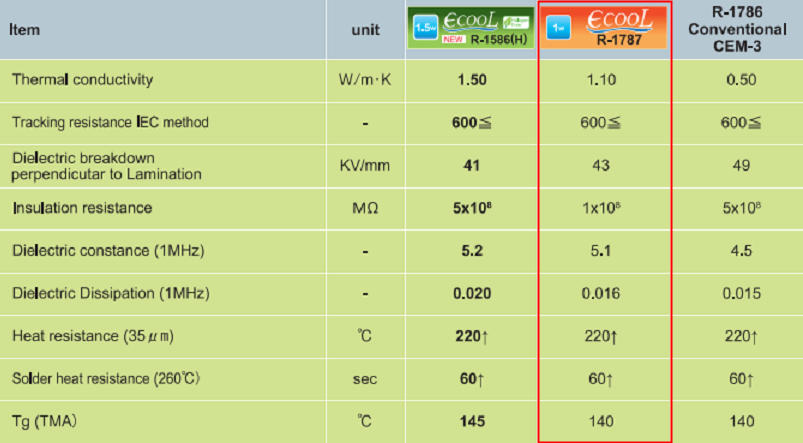 LED PCB MATERIAL
LED PCB MATERIAL
Commonly used LED pcb materials on the market are: FR-4, CEM and Aluminum, NKT LED Lighting usually use two types of PCB materials for our LED modules:
1, CEM PCB: Using CEM-3 PCB with LEDs has several advantages:
Lower cost: CEM-3 uses glass cloth and glass mat composite substrate, also known as composite substrate,
rather than pure glass cloth. CEM-3 is a composite copper clad laminate with a performance level between CEM-1 and FR-4
Better heat dissipation: the overall thickness of the PCB laminated material is within a range of 0.6 to 1.0mm. More preferably, the overall thickness of the PCB laminated material is within a range of 0.6 - 0.8mm. It is advantageous to have thinner PCB laminated material for decreasing thermal resistance
High thermal conductivity: CEM 3 PCB epoxy resin material allow thermal conductivity achieve at
1.7 W/mK at least
Good manufacturability: With excellent machinability, it can be processed to the style you want
Lightweight: The core of the circuit board made of CEM 3 has no extra weight from other materials. Shipping and handling become more cost-effective due to the lighter weight.
There are only a few companies worldwide which have CEM-3 material with thermal conductivity. The ones we purchase are from Panasoni made in Japan. The following characteristics will guide you to understand the CEM board, the red square is NKT LED Lighting mostly use.

2, Aluminum PCB: The use of aluminum PCBs also has advantages:
Better value: Aluminum saves production costs in two ways. Aluminum is more cost-effective compared to other metals. By choosing a board with this metal at its core, designs can avoid adding less cost-effective
heat sinks for thermal regulation.
Recyclable: Aluminum is easy to recycle and non-toxic.
Durable: Aluminum is stronger and more durable than glass, fiberglass or ceramic printed circuit boards,
especially against shock and thermal damage.
Improved Heat Transfer: Aluminum PCB cores transfer heat better than standard cores or other materials,
preventing thermal damage to LED components.
Please refer to below Characteristics for the aluminum board NKT LED Lighting mostly used(Red square):

LED PCB THICKNESS
LED pcb thickness is from 0.6mm ~ 3mm, choose the best thickness LED PCB according your fixtures, usually thickness more and price higher.
LED PCB THERMAL CONDUCTIVITY
The heat generated during the operation of the device is quickly conducted to the metal base layer through the insulating layer, and then the heat is transferred out by the metal base layer, thereby realizing the heat dissipation of the device.
At present, the thermal conductivity is mainly tested and tested according to ASTM D5470 (Standard Test Method for Thermal Conductivity of Thin Thermally Conductive Solid Insulating Materials).
The LED PCB themal conductivity usually is from 0.5 W/m.k to 8.0W/m.k. For indoor LED lights, 1.0-1.5W/m.k is enough, the higher power LED lights need more than 2.0W/m.k.
THEMAL RESISTANCE:
Thermal resistance refers to the ratio between the temperature difference between the two ends of the object and the power of the heat source when heat is transmitted on the object. The unit is Kelvin per watt (K/W) or Celsius per watt (°C/W). A high thermal resistance value means that heat is difficult to transfer, while a low thermal resistance value means that heat is easy to transfer.
VOLUMETRIC RESISTIVITY:
Volumetric resistivity or resistivity (ρ) is one of the measures of the electrical resistance or insulation resistance of a PCB material. The higher the resistivity of a material, the less likely it is to move charges, Resistivity is expressed in ohms-meters (Ω-m) or ohms-centimeters (Ω-cm)
As a dielectric insulator, the PCB material needs to have very high resistivity values, around 10⁸ Ω-cm. Resistivity is affected by moisture and temperature.
SURFACE RESISTIVITY:
Surface resistivity (ρS) is a measure of the electrical resistance or insulation resistance of the surface of a PCB material. Like the volumetric resistivity PCB materials need to have very high surface resistivity values. The surface resistivity of LED PCB is 10⁸Ω, The larger the resistance value, the better the insulation performance.
LED PCB COMBUSTIBILITY: UL 94 V-0:
Combustibility UL94 rating is the most common Combustibility standard used by many enterprises. It is generally used to evaluate the ability of a material to extinguish quickly after being ignited. V-0 is the highest class means the flame is extinguished within 30 seconds after two 10-second burn tests on the sample. No burning objects should fall.
DIELECTRIC CONSTANT(1MHZ):
Considering the dielectric constant of the material is important for signal integrity and impedance considerations, which are key factors in high frequency electrical performance. Most PCB materials have Er in the range of 2.5 to 4.5.
The dielectric constant varies with frequency and generally decreases with increasing frequency; the relative permittivity of some materials varies less than others. Materials suitable for high frequency applications are those whose dielectric constants remain relatively the same over a wide range of frequencies - from a few hundred MHz to a few GHz. Dielectric loss tangent or dissipation factor
DIELECTRIC LOSS(1MHZ):
The loss tangent of a material is a measure of the power loss of the material. The lower the loss tangent of the material, the less power is lost. The Tan delta of most PCB materials ranges from 0.02 for the most commonly used materials to 0.001 for very low loss high end materials. It also varies with frequency, increasing with frequency.
Loss tangent is generally not a critical consideration for digital circuits except at very high frequencies above 1Ghz. However, it is a very important parameter of an signal, as it determines the degree of signal attenuation, which affects the signal-to-noise ratio at various points in the simulation signal trace.


